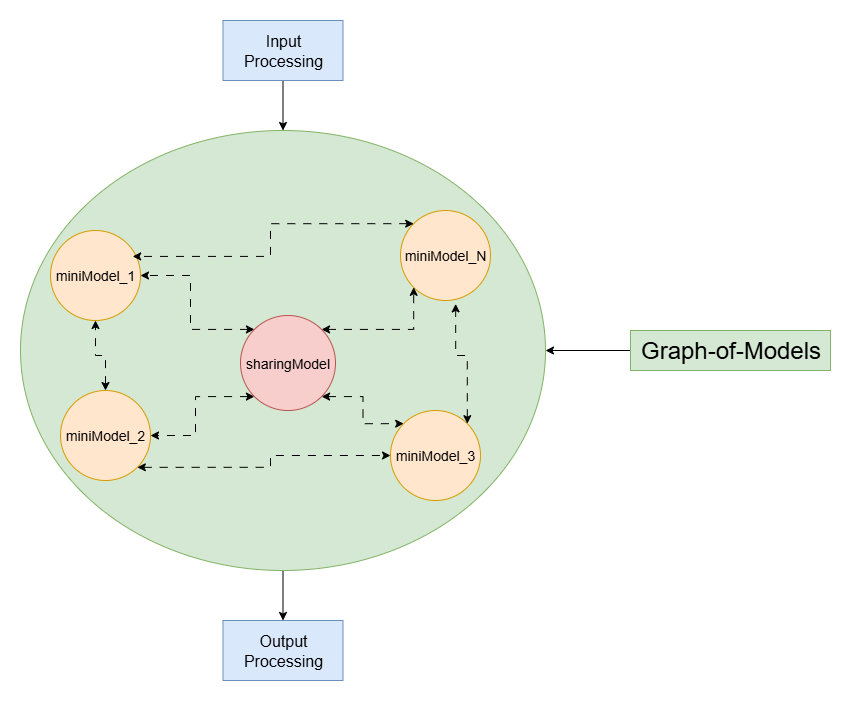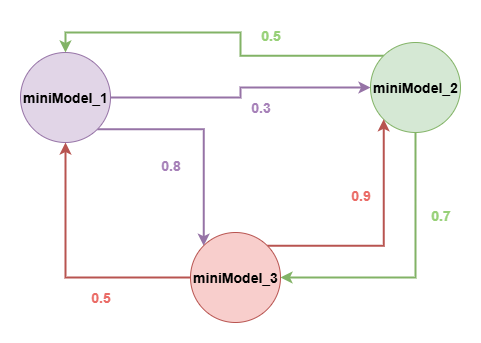Graph-of-Models - First Sketch
After hopeless moments, I think I figure a prototype idea for my work. Everything is less and less vague. Even though the limitations seem clear but if it can serve the final purpose, it is good.
First Draft

My first proposed structure.
The structure is simple, there are 3 main parts:
- Input Processing
- Graph-of-Models
- Output Processing
There are 2 major problems we need to encounter:
- How we shape the graph?
- How it will run?
The limitation of this work is the complexity to make the graph or input processing, and there is a concern about extending the graph. So there must be a sustainable method to make the algorithm of making graph brilliant and less hand-work.
First Idea
How to solve those 3 problems is a problem. I don’t know if I should read some papers about Multi-Agent AI @@.
How we shape the graph?

My imagination on how the graph should looks like. It’s something like Dijkstra graph (Bento et al., 2019).
To shape the graph, we need to calculate the relationship between the models which is based on the datasets we used to fine-tune.
To calculate this number like in the diagram above, there are some options that I am not sure which one is the best:
- Jaccard Index (Niwattanakul et al., 2013): This method seems faster to run, run on the raw dataset.
- Cosine Similarity (Gunawan et al., 2018; Dehak et al., 2010): This method seems slower as I need to convert the dataset into embeddings to calculate.
There are more advanced methods but I don’t have time to dig deeper yet. I think I will apply 2 classic methods first to see the efficiency.
The score will be stored and called relevancy score.
How it will run?
sequenceDiagram
participant User
participant routerLM
participant Graph-of-Models
participant reasoningLM
User->> routerLM: Input
routerLM->> Graph-of-Models: Routing Decision
Graph-of-Models->>reasoningLM: Summary Information
reasoningLM->> User: Output

My workflow I propose in this post :)
- Step 1: User will input his requirement.
- Step 2:
routerLMwill choose the most relevant model based on input (inspired from (Zhang & Soh, 2024)). - Step 3: In this step I first plan to run sequencely, but there is a work hinting we can run parallel (Song et al., 2025).
- Extract general info about the input in
sharingModel. - Use suitable PROMPT to extract relevant info from most relevant model, let call
miniModel_1(step 2) and 2nd model has highest relevance score tominiModel_2, let call this model isminiModel_2.
- Extract general info about the input in
- Step 4: general info + relevant info will be sent to
reasoningModelto give final output.
First Step
2 goals: Fine-tuned model and graph visualization
Here is my collection of the models and datasets I collect for this project: vtrnnhlinh’s Collection: Graph-of-Models.
I plan to make a graph of models finetuned related to food, with the datasets about fruits, recipes and drinks. I choose small models to do, cause my personal laptop has limited resources lol.
After that, I will calculate Jaccard Index and Cosine Similarity and visualize the graph with its relation score.
I think this “first step” is already a huge problem to a noob like me already, lol.
Look forward to share next things :>
References
- Dijkstra graphsDiscrete Applied Mathematics, Sep 2019
- Using of Jaccard coefficient for keywords similarityIn Proceedings of the international multiconference of engineers and computer scientists, Sep 2013
- The implementation of cosine similarity to calculate text relevance between two documentsIn Journal of physics: conference series, Sep 2018
- Cosine similarity scoring without score normalization techniques.In Odyssey, Sep 2010
- Extract, define, canonicalize: An llm-based framework for knowledge graph constructionarXiv preprint arXiv:2404.03868, Sep 2024
- Gradientsys: A Multi-Agent LLM Scheduler with ReAct OrchestrationSep 2025
Enjoy Reading This Article?
Here are some more articles you might like to read next: